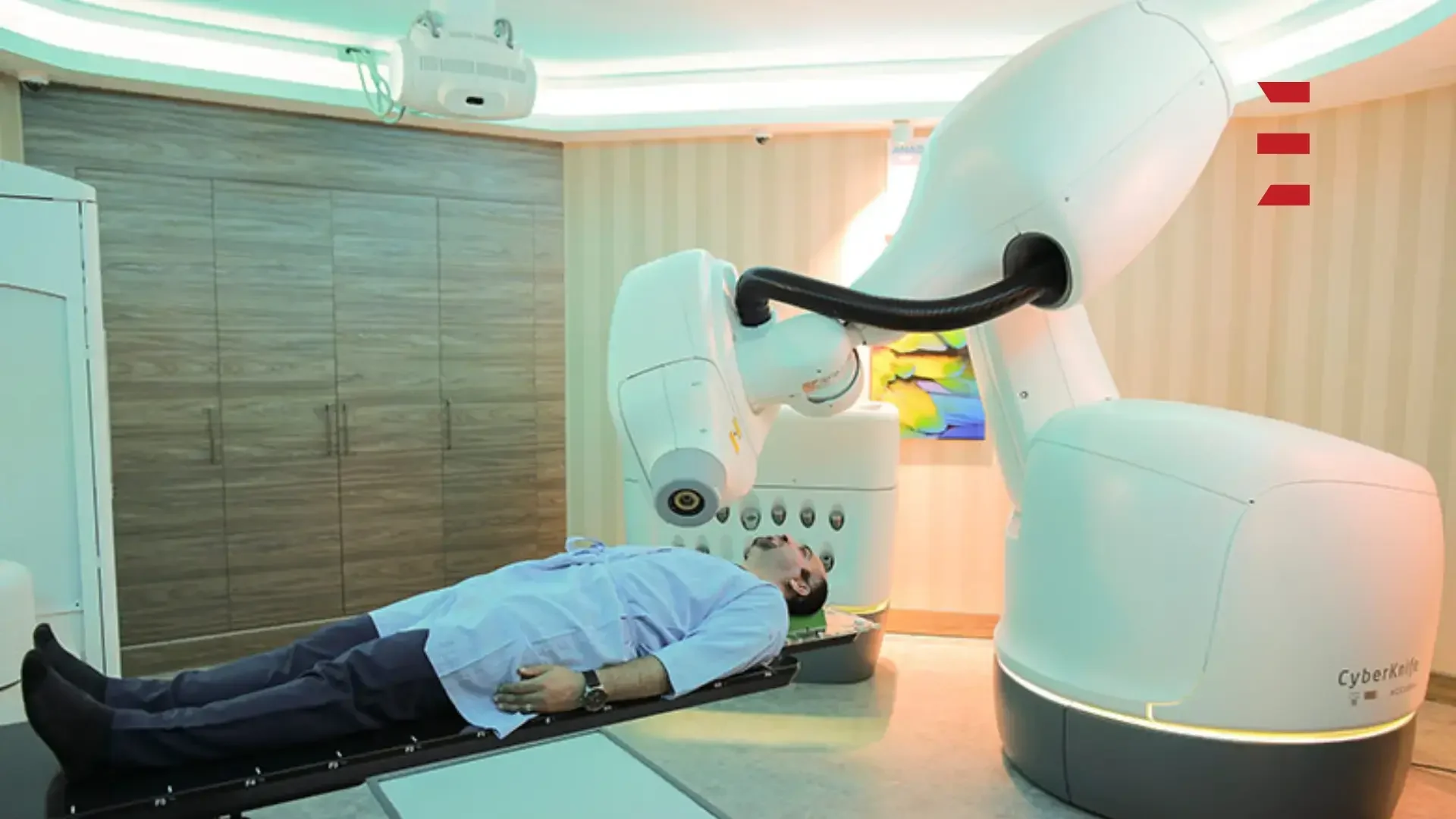Receiving a difficult diagnosis can be stressful, and understanding your options for care is crucial. CyberKnife technology is a great option if you’re looking for a targeted and less intrusive method. With the help of robotic technology, this new treatment delivers targeted therapy right to the disease site, offering a less invasive approach that can alleviate some of your concerns and anxieties.
Market.us estimates that the size of the worldwide cyberknife market will increase from its present value of USD 780 million in 2022 to USD 2,417 million by 2032, showing a remarkable CAGR of 12.3% between 2023 and 2032.
This comprehensive guide is designed to leave no stone unturned in its exploration of Cyberknife. It delves into its operation, advantages, disadvantages, and potential candidates for this therapy modality. By providing you with all the necessary information, this guide ensures that you are fully informed and empowered in your healthcare decisions, alleviating potential stress or uncertainty.
So continue reading to learn about Cyberknife and how it might help you in your health-related battle!
What is CyberKnife?
The CyberKnife System is a non-invasive therapeutic strategy for cancerous and non-cancerous tumors and other disorders where radiation therapy is appropriate. It is the first and only fully robotic radiation device worldwide. This method is used as a substitute for surgery in cases of inoperable or surgically complicated tumors and to treat disorders of the prostate, lung, brain, spine, head and neck, liver, pancreas, and kidney, among other body parts. Treatments with CyberKnife are usually completed in one to five sessions.
CyberKnife Treatment uses external beam radiation with a customized device branded CyberKnife. This advanced technique delivers stereotactic body radiation therapy (SBRT) and stereotactic radiation therapy (SRS). Contrary to its name, CyberKnife treatment doesn’t include cutting, surgery, or general anesthesia. Rather, it uses a radiation-emitting linear accelerator fixed on a robotic arm. Because of its special configuration, radiation beams can be delivered precisely and with unmatched accuracy from various angles.
What are the Advantages & Disadvantages of CyberKnife?
CyberKnife technology has transformed radiation therapy. It provides several advantages for patients. However, there are some disadvantages, too. Let’s discuss both.
Advantages:
Minimally Invasive: CyberKnife is a non-invasive procedure that is different from traditional surgery. This eliminates the need for scalpels, cuts, and stitches, hastening the healing process and lowering the chance of infection.
Accurate Targeting: CyberKnife is very accurate. Its robotic arm and image guidance system deliver high radiation dosages directly to the tumor, limiting damage to nearby healthy tissues. This precision can be especially helpful when treating tumors close to vital organs or in delicate regions.
Reduced Side Effects: CyberKnife’s focused methodology considerably lowers the chance and intensity of radiation therapy-related side effects. These may include drowsiness, nausea, and rashes on the skin.
Less Treatment Sessions: Conventional radiation therapy frequently necessitates several sessions over several weeks. In contrast, CyberKnife can usually finish therapy in just one to five sessions. Patients will find this shortened timetable more convenient and less disruptive to their regular routines.
Versatility: CyberKnife’s applications go beyond the treatment of cancer. It can be used to treat a variety of diseases, such as benign tumors and vascular abnormalities, that benefit from targeted radiation therapy.
Potential Substitute for Surgery: CyberKnife can be a good option for specific individuals whose tumors are inoperable or complicated. It can be especially helpful for people with underlying medical issues who might not be the best candidates for standard surgery.
Proven Track Record: For more than twenty years, the CyberKnife System has effectively treated a wide range of illnesses for thousands of patients. Knowing that it has a proven track record can ease those thinking about this therapy option.
CyberKnife provides a precise, streamlined, and minimally invasive method that enables patients to combat their ailment with less discomfort and disruption to their everyday routines. If you’re considering radiation therapy choices, talk to your doctor about the possible advantages of CyberKnife to determine if it’s a good fit for you.
Disadvantages:
Although CyberKnife has several benefits, it’s necessary to be aware of some potential side effects and disadvantages:
Not Ideal for All: CyberKnife is versatile yet inappropriate in every situation. When deciding whether CyberKnife is the best option, your doctor will consider various aspects, such as the type, location, and tumor size.
Cost: Compared to conventional radiation therapy, CyberKnife treatment can be costly. Insurance coverage varies, so it’s important to confirm in advance with your provider.
Several Sessions: CyberKnife therapy requires fewer sessions than traditional therapy, but it still requires several in-person appointments for treatment, which can take time.
Painful at First: Despite being non-invasive, some individuals could feel uncomfortable while receiving treatment. If you need to discuss pain management choices, speak with your doctor.
Long-Term Effects: Years after radiation therapy, there is a slight chance that long-term negative effects will manifest. These possible dangers can be discussed with your doctor.
Remember that everyone has different experiences. It’s crucial to discuss openly with your physician the possible advantages and disadvantages of CyberKnife in light of your unique circumstances. However, if you want to learn anything about artificial intelligence, seek guidance from a leading Artificial Intelligence development company in the USA.
What’s the Difference Between CyberKnife and Gamma Knife?
The main distinctions between CyberKnife and Gamma Knife:
1. Treatment Method:
CyberKnife: Non-invasive; patient positioning is achieved via a soft, pleasant mesh mask.
Gamma Knife: An invasive operation requiring a stiff head frame implanted into the skull.
2. Precision:
CyberKnife: Real-time imaging, a robotic arm, and movement-adaptive tumor tracking technologies combine to provide sub-millimeter accuracy.
Gamma Knife: The headframe reduces patient movement while achieving sub-millimeter accuracy.
3. Flexibility in Treatment:
CyberKnife: This treatment approach uses a flexible robotic arm and delivers numerous lower-dose and single high-dose sessions. Both strategies reduce side effects and harm to adjacent tissues.
Gamma Knife: It increases the risk of damaging surrounding healthy tissues and is limited to a single, high-dose treatment administered from a stationary position.
4. Anesthesia:
CyberKnife: No need for anesthesia
Gamma Knife: May need local or general anesthesia
5. Treatment Area:
CyberKnife: This device can treat malignancies anywhere in the body thanks to its robotic architecture and real-time imaging guidance.
Gamma Knife: Only used to treat cancers inside the skull and in some cervical spine instances.
6. Uses:
CyberKnife: The FDA has approved this device to treat cancers in any part of the body, including the head, neck, spine, and brain.
Gamma Knife: Because of the head frame’s immobilizing properties, this tool is mostly used for treating brain cancers and some specific cervical spine tumors.
7. History:
CyberKnife: Created in the year 2001
Gamma Knife: It was created in 1967
Who is Eligible For CyberKnife Treatment?
Certain cancer treatments have historically had drawbacks. For example, certain patients may find surgery excessively risky, or there may be dosage restrictions with radiation therapy. CyberKnife’s ability to increase the number of people eligible for cancer therapy is one of its main benefits.
Here’s how CyberKnife facilitates easier access to treatment:
CyberKnife is an excellent choice for tumors that are thought to be inoperable because of their intricacy or location.
It is a suitable alternative for younger and older patients who might not handle a frame well, as specific radiosurgery procedures do not require a rigid head frame.
CyberKnife provides a minimally invasive alternative to traditional open surgery, which may include lengthy recovery periods.
CyberKnife’s focused technique may enable continued treatment even if you’ve received the maximum radiation dose permitted with conventional treatments.
Its frameless design eliminates the need for a stereotactic frame, which some patients may find unpleasant.
CyberKnife can target remaining or recurrent malignancies without requiring additional major surgery.
Increasingly being used to treat problems for which radiosurgery may not have been beneficial in the past.
CyberKnife can be used in addition to conventional cancer treatments, such as chemotherapy, to increase the efficacy of your treatment regimen overall.
Provides new hope for those facing challenging circumstances by increasing access to cancer treatment for a larger variety of patients.
What’s the Difference between CyberKnife and Radiation?
CyberKnife and traditional radiation therapy differ primarily in their delivery techniques and levels of accuracy.
Delivery Method:
CyberKnife precisely targets the tumor while avoiding damage to surrounding healthy tissue by using a robotic arm to deliver highly focused radiation beams from multiple angles.
Radiation is usually delivered to the tumor from a few fixed angles using a linear accelerator in traditional radiation therapy. The course of treatment may need to be completed in more than one session with this less accurate method.
Precision:
CyberKnife uses modern imaging technologies, including image guiding and real-time monitoring, to continually monitor and modify the tumor’s location during treatment, delivering precise radiation delivery.
Radiation therapy might not use the most effective imaging methods available, making it difficult to accurately target cancers that are moving or close to important structures.
CyberKnife provides increased accuracy and adaptability in delivering radiation therapy, enabling the administration of larger dosages to the tumor while lowering the possibility of negative impacts on the surrounding healthy tissue.
Final Words!
A cancer diagnosis might be daunting, but knowing what treatments you have access to is powerful. CyberKnife technology may be a good choice if you’re looking for a focused and minimally intrusive strategy. With a less invasive method that can allay your fears, this AI-driven treatment uses robotic technology to deliver radiation to the tumor spot precisely.
We hope this guide has provided enough information about CyberKnife, its features, benefits, drawbacks, and potential users. This guide seeks to reduce possible stress or uncertainty by providing the information you need to make an informed decision about your healthcare.
Frequently Asked Questions FAQs:
How big of a tumor can CyberKnife cure?
According to some authentic sources, the largest diameter of the tumor is between 1.8 and 18 cm.
When is it not advised to use CyberKnife?
Hormone therapy can be administered to some individuals with enlarged prostates in an attempt to reduce the prostate size so that Cyberknife treatment is possible. Cyberknife is not a good option for patients with cancer in their lymph nodes or those at high risk of lymph node spread.
How effective is CyberKnife therapy?
Cyberknife therapy is more effective than conventional radiation, according to new research. It’s a quicker option because treatment can be finished in as few as five sessions. Cyberknife patients showed a 96% 5-year disease control rate, whereas patients receiving traditional radiation therapy showed a 95% disease control rate.















